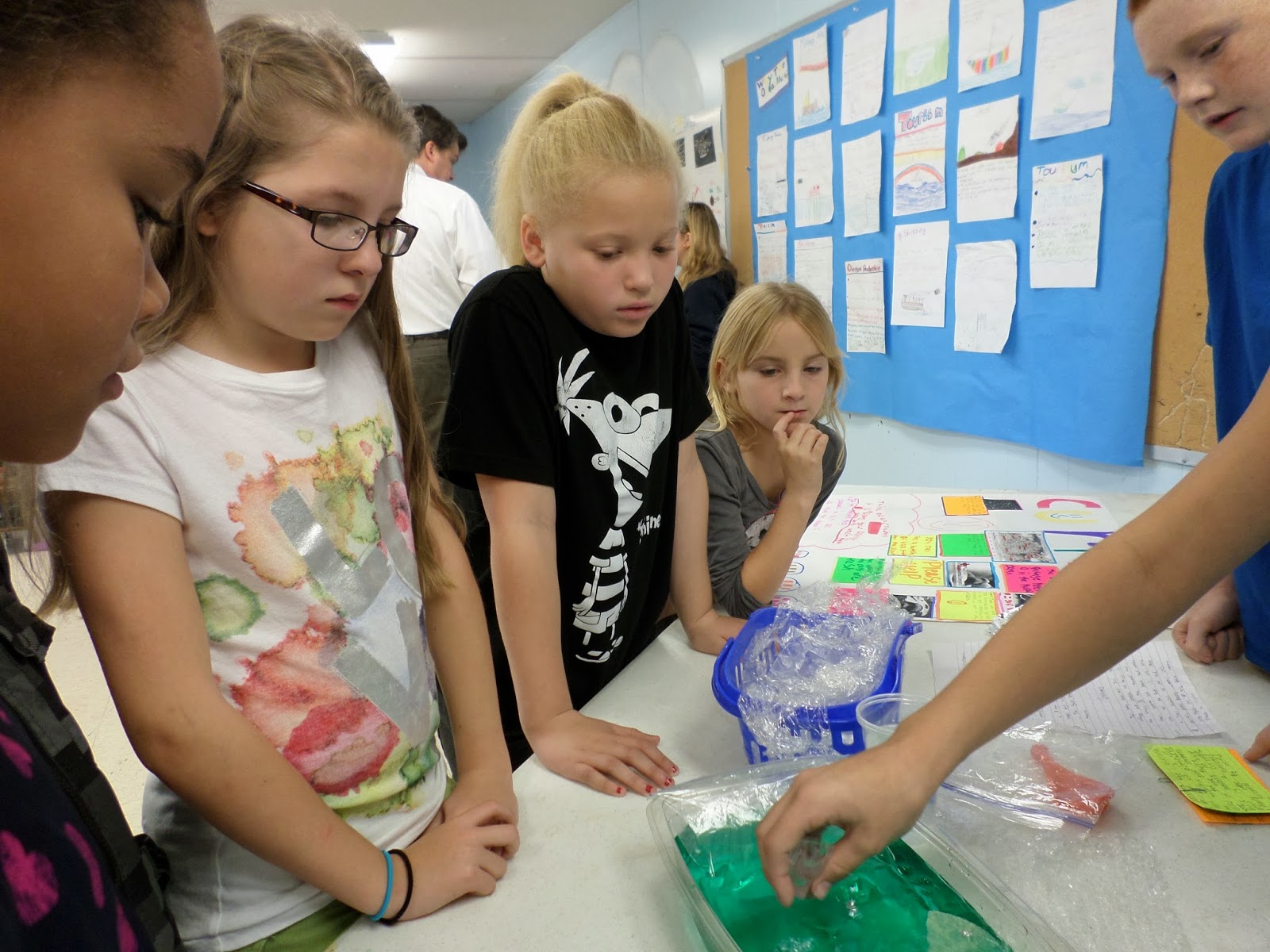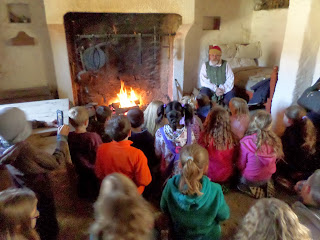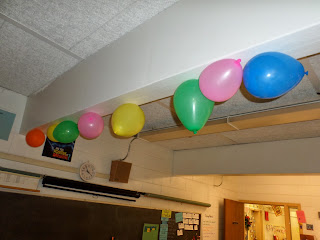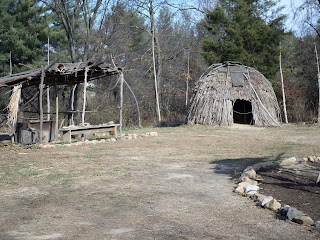Today we had fun in science with static electricity experiments. Ask your student what he/she would have to do to end up with balloons on the ceiling!
Thursday, December 12, 2013
Monday, December 2, 2013
Pollution and the Chesapeake Bay
My apologies for the delay! On the 21st of November, Mrs. Kaufmann's class and our class gave presentations to several people who work in various positions at central office, including the director of elementary education and the science lead for the county. They were impressed!
Each group showed a demonstration about how pollution affects the Chesapeake Bay and offered a proposal for how we can help the environment/watershed here at school. The groups did a great job explaining their thinking and offering ideas for improvement here at the school. Ask your child how he/she did!
The light switch cover contest came to an end on Tuesday, November 26th. The group who held the contest will be reviewing entries (there were A LOT!) and we will have a winner soon! Stay tuned!
Each group showed a demonstration about how pollution affects the Chesapeake Bay and offered a proposal for how we can help the environment/watershed here at school. The groups did a great job explaining their thinking and offering ideas for improvement here at the school. Ask your child how he/she did!
 |
| Learning about hot and cold currents from one of Mrs. Kaufmann's groups |
 |
| One group's demonstration about soil and forest buffers |
 |
| How pollution affects watersheds |
 |
| Different polluting factors build on one another |
 |
| Lots of different variables affect the Bay |
 |
| One group held a school-wide contest to design new light switch covers |
 |
| Here are a few early entries for the contest |
Wednesday, November 13, 2013
Frontier Museum
On Monday, we visited the Frontier Culture Museum in Staunton, Virginia. We spent the day outdoors, walking from exhibit to exhibit at the museum. The Frontier Museum tells the story of the thousands of people who migrated to Colonial America. The first pioneers came to American during the 1600s and 1700s from communities in England, Germany, Ireland, and West Africa.
To tell the story of these immigrants, the museum has moved examples of traditional rural builidings from Germany, England, Ireland, West Africa and America. The Old World exhibits show rural life and culture in the four homelands of early immigrants. The American exhibits show the life that the colonists and their descendants created in the early United States.
1700s Ireland
1700s Germany
To tell the story of these immigrants, the museum has moved examples of traditional rural builidings from Germany, England, Ireland, West Africa and America. The Old World exhibits show rural life and culture in the four homelands of early immigrants. The American exhibits show the life that the colonists and their descendants created in the early United States.
1700s Ireland
 |
| Gathered around the fire listening about life in rural Ireland |
 |
| Trying on wooden shoes that German children wore to gather firewood and do other outdoor chores |
 |
| Straining milk for curds and whey |
 |
| Drawing water from a well |
 |
| Not so sure about having to draw water from the well for every need |
1600s England
 |
| 1600s English farm house |
 |
| Fertilizing the garden with manure |
 |
| Shoveling manure for the garden |
 |
| The English farmhouse we saw was from an upper middle class family and had real glass! |
1700s West Africa
 |
| Carrying baskets |
 |
| Entrance |
1700s Native American Encampment
 |
| Hollowing out a tree trunk to have a canoe |
1740s American Settlement
 |
| Early American "starter house". These houses were temporary and built to last until the settlers were able to tell if they would be able to survive by farming their new land. |
 |
| Sawing logs to build a house |
1820s America
 |
| Hearing about English, German, and Irish influences to American houses |
1850s American School House
 |
| The boys writing on slates |
 |
| The school teacher |
 |
| The girls trying their hand at writing on slates |
We had a great time exploring the early beginnings of Virginia and the United States!
Monday, November 11, 2013
Ecosystems!
On Friday we started our new science unit, ecosystems and habitats. Here are a few great sites for building background.
Living Systems Matching Exercise
Habitats and Food Chain Exercise
Study Jams on Ecosystems
Habitats Quiz on Quia
Energy Pyramids
Food Chains versus Food Webs Exercise
Virtual Owl Pellets Dissection
Fun with Food Webs
Build a Food Web
Food Chains Game
Walk the Plank on Ecosystems
Name It! Living Systems
Life Cycles Practice
Living Systems Matching Exercise
Habitats and Food Chain Exercise
Study Jams on Ecosystems
Habitats Quiz on Quia
Energy Pyramids
Food Chains versus Food Webs Exercise
Virtual Owl Pellets Dissection
Fun with Food Webs
Build a Food Web
Food Chains Game
Walk the Plank on Ecosystems
Name It! Living Systems
Life Cycles Practice
Saturday, November 2, 2013
Halloween! & the End of the First Nine Weeks
A big thank you to Mrs. Brookman, Mrs. Lilly, and Mrs. Walker for coming in on Halloween. The class thoroughly enjoyed listening to a Halloween story and having delicious homemade cupcakes and juice!
Enjoy your gorgeous fall weekend and I will see you on conference day on Tuesday!
Tuesday, October 22, 2013
Guest Speakers
First, we had a speaker from the Virginia Department of Forestry come talk to us about the importance of forests in the protection of the Chesapeake Bay watershed. She did a demonstration about polluted water and showed how trees and vegetation near banks of rivers (and other water sources) can help reduce pollution.
To follow up with her talk, we made our own "polluted" water and built water filters out of various materials to see which ones would function best as filters.
Second, we had a speaker from the Hanover-Caroline Soil and Water Conservation District who talked more about our watershed address, watersheds in general, and the importance of soil as a natural resource. She did two demonstrations that really hit home the concept of a watershed.
 |
| A demonstration to show the importance of vegetation in filtering pollution from water sources |
 |
| Various pollutants on a small watershed model |
 |
| Look at that polluted water! (upper middle in picture) |
Friday, October 4, 2013
Updated Pages
Please check out the Reading & Language Arts page for information on our word study program this year.
Updates on the Science, VA Studies, and Math pages coming soon!
Happy Friday!
Wednesday, October 2, 2013
Watersheds and Salt Dough Maps
This week we have been getting our hands dirty with watershed models and salt dough maps.
On Monday, we used soil, food coloring, blocks, foil, and water to simulate what happens with pollution in our Chesapeake Bay watershed. Ask your students what we discovered!
We are having a great week so far!
On Monday, we used soil, food coloring, blocks, foil, and water to simulate what happens with pollution in our Chesapeake Bay watershed. Ask your students what we discovered!
 |
| Our rudimentary watershed model |
On Tuesday, we used the salt dough that was made at home to make a map of Virginia's regions. The class did a really nice job and I was impressed with the variety of bright colors that came in!
 |
| Salt dough can be messy! |
Thursday, September 26, 2013
Indoor Recess Successes
As you may have heard, we had an issue with snakes on our playground and had to have an expert come out and help us make sure all is well before opening up the playground again.
While this means we have been bummed to be inside all of this gorgeous fall weather week, we are making the best of it! Look at the tower some of the class worked on today:
While this means we have been bummed to be inside all of this gorgeous fall weather week, we are making the best of it! Look at the tower some of the class worked on today:
 |
| As you may have guessed, the tower toppled shortly after the photo was taken... |
Friday, September 20, 2013
OREO Challenge & An Exciting Opportunity
Oreo Challenge
Today, we talked about habit 6, synergy. Synergizing is about working together, sharing results, and collaborating for a shared opportunity.
We partcipated in an activity called O.R.E.O. (Our Really Exciting Online project) that schools from all around the world are also participating in. The goal of the project was to obtain a class average of Oreos that could be stacked in a single stack. Taking turns, each child in the class stacked oreos, one by one, until his/her stack toppled. Our average was 14 and our highest stack had 27 oreos! We talked about factors involved in the varying numbers of each stack and we talked about the concept of an average. Once the activity ends on October 1st, we will check the results page and see what other schools found out. It looks like the average from all of the schools that have participated so far is 18 oreos.
Today, we talked about habit 6, synergy. Synergizing is about working together, sharing results, and collaborating for a shared opportunity.
We partcipated in an activity called O.R.E.O. (Our Really Exciting Online project) that schools from all around the world are also participating in. The goal of the project was to obtain a class average of Oreos that could be stacked in a single stack. Taking turns, each child in the class stacked oreos, one by one, until his/her stack toppled. Our average was 14 and our highest stack had 27 oreos! We talked about factors involved in the varying numbers of each stack and we talked about the concept of an average. Once the activity ends on October 1st, we will check the results page and see what other schools found out. It looks like the average from all of the schools that have participated so far is 18 oreos.
 |
| Carefully stacking |
 |
| And, there it goes... |
Exciting Opportunity
This week, we had an exciting opportunity brought to us. Mr. Joseph chose Mrs. Kaufmann and I's classes to help him with a special project involving schools and pollution. Our classes will be exploring how Virginia schools (Beaverdam specifically) are polluting the Chesapeake Bay and what we can do to help slow or stop it. Our students will be creating models to show how this pollution is affecting the Bay and they will develop ideas for what can be done. In the process of working on this challenge for Mr. Joseph, we will learn about Virginia's natural resources and the Chesapeake Bay watershed. So far, we have made a list of questions that we need to answer in order to answer the questions being put to us! Stayed tuned for updates!
Monday, September 16, 2013
Back to School Night
My apologies for the late notice, but ... Back to School Night is tomorrow! The teacher introductions and short PTA meeting begin at 6:30 and classroom visits begin at 7. There will be 3 fifteen-minute sessions in the classrooms, with the hopes that you will be able to make it to the classrooms of all of your children.
Hope to see everyone tomorrow night!
Tuesday, September 10, 2013
First Week - Done!
What a busy first week we had! We focused on getting situated in a new classroom and learning new procedures and routines. Everyone seems to be acclimating quite nicely. I have had several class compliments from resource teachers, which always makes me proud!
This week, we will be working on beginning year assessments and we will be getting started with curriculum.
Language Arts: We are working on...
- remembering read to self and work on writing procedures
- learning/remembering what synonyms and antonyms are
- using a thesaurus to broaden vocabulary
- spelling and reading level assessments
Math: We are working on...
- number of the day (a number sense warm up)
- line and bar graphing
Science: We are working on...
- learning about natural and human-made resources in general and in Virginia
- learning what scientists do and how scientists act
Social Studies: We are working on...
- learning about absolute and relative location
- memorizing our home address
- knowing how to describe Virginia's location, including bordering states and bodies of water
Next week, we will have a fun activity that involves oreos! Be on the look out for more information about our mini in-class project and for pictures!
This week, we will be working on beginning year assessments and we will be getting started with curriculum.
Language Arts: We are working on...
- remembering read to self and work on writing procedures
- learning/remembering what synonyms and antonyms are
- using a thesaurus to broaden vocabulary
- spelling and reading level assessments
Math: We are working on...
- number of the day (a number sense warm up)
- line and bar graphing
Science: We are working on...
- learning about natural and human-made resources in general and in Virginia
- learning what scientists do and how scientists act
Social Studies: We are working on...
- learning about absolute and relative location
- memorizing our home address
- knowing how to describe Virginia's location, including bordering states and bodies of water
Next week, we will have a fun activity that involves oreos! Be on the look out for more information about our mini in-class project and for pictures!
Friday, August 30, 2013
Welcome to 4th Grade!
Welcome to Room 111. I enjoyed meeting everyone who was able to stop by open house yesterday. I am so excited to have you in our class this year! I hope you're ready for real life problem-solving -- also known as problem-based learning. YOU are in charge of your education. We will get started the very first day so come in rested and ready to learn!
A few things about our classroom:
See you Tuesday!
A few things about our classroom:
- We will have snack each day. Healthy items, please. Examples - fruit, vegetables, crackers, nuts, cheese, etc. Water only, please.
- We will have recess each day so be prepared to go outside and move!
- We learn A LOT every day and we have fun every day.
- We are a family - everyone is safe to learn in our room. We will all make plenty of mistakes and we'll all be very successful.
See you Tuesday!
Thursday, August 1, 2013
VISTA
This summer, Mrs. Kaufmann and I participated in the VISTA Elementary Summer Institute. We spent a month working with teachers from surrounding counties learning, creating, and practicing all kinds of great things about SCIENCE! We are excited to implement the problem based learning (PBL) strategies we have learned this summer.
VISTA stands for Virginia Institute for Science Teaching and Achievement and the program aims to improve science teaching by helping teachers learn to apply the principles of hands-on science, student-centered inquiry, the nature of science, and problem-based learning. This year, Mrs. Kaufmann and I will experiment with using these techniques in the classroom. We also we have the opportunity to have a master teacher as a coach throughout the year who will come and assist in our classrooms.
 |
| Working with some of the students that came to the VISTA summer camp |
 |
| One of the wind-powered vehicles that we made |
 |
| Being proactive .. scientists wear goggles! |
 |
| Planning with Mrs. Kaufmann |
Subscribe to:
Comments (Atom)













